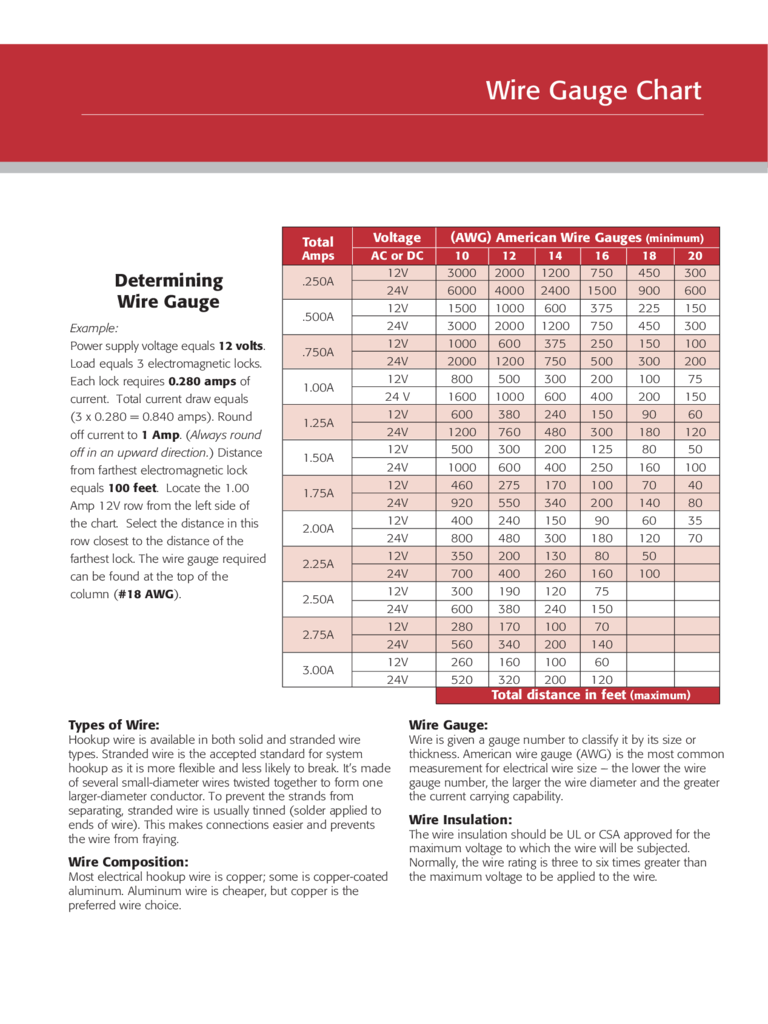Fillable Printable Sample Wire Gauge Chart
Fillable Printable Sample Wire Gauge Chart

Sample Wire Gauge Chart

Total
Voltage
(
AWG
)
American Wire Gauges
(minimum)
Amps AC or DC 10 12 14 16 18 20
.250A
12V 3000 2000 1200 750 450 300
24V 6000 4000 2400 1500 900 600
.500A
12V 1500 1000 600 375 225 150
24V 3000 2000 1200 750 450 300
.750A
12V 1000 600 375 250 150 100
24V 2000 1200 750 500 300 200
1.00A
12V 800 500 300 200 100 75
24 V 1600 1000 600 400 200 150
1.25A
12V 600 380 240 150 90 60
24V 1200 760 480 300 180 120
1.50A
12V 500 300 200 125 80 50
24V 1000 600 400 250 160 100
1.75A
12V 460 275 170 100 70 40
24V 920 550 340 200 140 80
2.00A
12V 400 240 150 90 60 35
24V 800 480 300 180 120 70
2.25A
12V 350 200 130 80 50
24V 700 400 260 160 100
2.50A
12V 300 190 120 75
24V 600 380 240 150
2.75A
12V 280 170 100 70
24V 560 340 200 140
3.00A
12V 260 160 100 60
24V 520 320 200 120
Total distance in feet
(
maximum
)
Determining
Wire Gauge
Example:
Power supply voltage equals 12 volts.
Load equals 3 electromagnetic locks.
Each lock requires 0.280 amps of
current. Total current draw equals
(3 x 0.280 = 0.840 amps). Round
off current to 1 Amp. (Always round
off in an upward direction.) Distance
from farthest electromagnetic lock
equals 100 feet. Locate the 1.00
Amp 12V row from the left side of
the chart. Select the distance in this
row closest to the distance of the
farthest lock. The wire gauge required
can be found at the top of the
column (#18 AWG).
Types of Wire:
Hookup wire is available in both solid and stranded wire
types. Stranded wire is the accepted standard for system
hookup as it is more flexible and less likely to break. It’s made
of several small-diameter wires twisted together to form one
larger-diameter conductor. To prevent the strands from
separating, stranded wire is usually tinned (solder applied to
ends of wire). This makes connections easier and prevents
the wire from fraying.
Wire Composition:
Most electrical hookup wire is copper; some is copper-coated
aluminum. Aluminum wire is cheaper, but copper is the
preferred wire choice.
Wire Gauge:
Wire is given a gauge number to classify it by its size or
thickness. American wire gauge (AWG) is the most common
measurement for electrical wire size – the lower the wire
gauge number, the larger the wire diameter and the greater
the current carrying capability.
Wire Insulation:
The wire insulation should be UL or CSA approved for the
maximum voltage to which the wire will be subjected.
Normally, the wire rating is three to six times greater than
the maximum voltage to be applied to the wire.
Wire Gauge Chart



